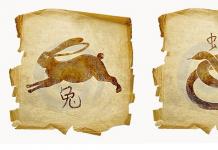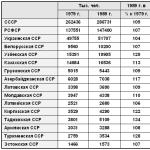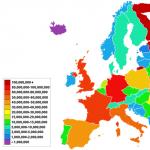Malaysia and Indonesia are two large countries located in Southeast Asia. Both countries speak Malay or a derivative of it and have many similarities to Indonesian. Many linguists believe that the Indonesian language is actually one of the variations of the Malay language. However, these closely related languages have many differences, but rather not of a grammatical, but of a phonetic order.
Malay - Bahasa Melayu - one of the Austronesian languages - the Malayo-Polynesian branch. The Malay language has official status in Brunei, Malaysia, Singapore and Indonesia. It is spoken by more than 270 million people.
From the history of the formation of the Malay language
According to one theory, the first who began to populate the islands of the Pacific Ocean, including the current territories of Malaysia and Indonesia, were ancient people, relatives of Denisovan man, whose bones were found in Altai in one of the caves. Later waves of migration brought with them migrants from South India, as well as Mongoloid migrants from southern China. However, unlike many other Asian languages, Malay does not have many inclusions from the languages of ancient India, including Sanskrit and Pali, or Chinese. In this sense, Malay is a unique and not unlike other language.
The Malay language has no cases, gender or numbers. The plural may be clear from the context or indicated by reduplication of the word, e.g. shirts = shirt-shirt. In addition, there are special classifiers to denote multiple languages, as in Chinese. Auxiliary words are used to indicate gender. Verbs have several conjugations - six classes.
The Malaysian language is characterized by the use of affixes, suffixes, infixes and circumfixes. This method of creating new words by adding complements to the stem is vaguely reminiscent of the use of prepositions, suffixes and endings in the Russian language.
The basic order of words in a sentence (topology) is also original: as a rule, the predicate (S) comes first, then the direct object (D), then the subject (P). This word order is also characteristic of some other languages of Oceania, South America and Madagascar.
- S - D - P
- Reading - book - student ( Student reading a book)
- Broke - pot - man ( The man broke the pot)
- Holds - a cow - Ivan ( Ivan holding a cow)
Rumi Malay alphabet based on Latin script
Currently, the Malay language almost universally uses a Latin-based alphabet - Rumi. To indicate all the necessary sounds, only basic Latin characters are used, without diacritics and other special characters.
MALAY
- one of the Austronesian languages (Malayo-Polynesian branch, western “subbranch”, according to the traditional classification - Indonesian languages). Distributed in a number of areas of the island. Sumatra (with adjacent islands), on the Malacca Peninsula, o. Singapore, the Riau and Lnga archipelagos, and enclaves in the coastal areas of the island. Kalimantan. Number of speakers approx. 26 million people Official the language of the Federation of Malaysia and Brunei Darussalam (along with English), the Republic of Singapore (along with English, Chinese, Tamil); for M. I. Since 1969, the name of Malaysia has been officially established. Malaysian language. Until 1942 it was used as a second official. language of the Netherlands Indies (along with Dutch), until 1945 - the second official language. the language of Indonesia (along with Japanese). Since 1945 - office. the language of the Republic of Indonesia is called Indonesian language. Since the early Middle Ages, M. i. used as an interethnic language. communication and interstate connections throughout the entire area of the Malay “coastal civilization” (Malayan arch., Malacca Peninsula, coast of Indochina and N. Guinea); was the language of the spread of Islam and Christianity. On M. I. there was a rich literature of various types. traditional genres and translation. Dialects are poorly studied. There are different territorial dialects (Delhi, Pa Lembang, Seraway, Pasemah on the island of Sumatra; Riau on the Riau islands; Perak, Kelantan, Trengtanu, Patan, Johor, Kedah on the Malacca Peninsula; Kutei, Banjar, etc. on the island . Kalimantan) and pidginizir. dialects of Jakarta, Ambon, Menado, Irian, Thailand. Typologically M. I. - a typical representative of Indonesia. languages of the B. Sunda Islands (according to another classification, Western Malayo-Polynesian languages). The sounds [i] and [e], [i] and [e] are not completely isolated as phonemes, often appearing as allophones: kukuh~kokoh "steadfast", genting~genteng "tile". Some specific features of primordial vocalism: the presence of a vowel phoneme [e] of the middle row of the middle rise, short, not found in the final syllable of bisyllables and under stress in other positions; the presence of diphthongs , , , standing in the final syllable of the root morpheme. The phenomenon of a peculiar synharmonicity of vowels in a word was noted. In consonantism: a full series of nasal sonants in any position (including before homorgan stops); middle-lingual noisy stops only in initial-syllabic position; glottal stop [?] as an allophone (k) in final syllabic position and as an optional epenthesis at the beginning of a word and in intervocalic position; implosive pronunciation of noisy words (also when deafening voiced ones); [w] and [j] as initial syllabic phonemes and as glides in intervocalic position; phonemes [f], [z], [s] in mastered borrowings as allophones of the original [р], [$]. [s] (with stylized coloring). In semantic differentiation, only segmental means are used (without longitude/brevity), tonal and dynamic. signs phonologists h. do not matter. Grammar build M. I. differs, that is, in analyticism. Basic morphological the category of the verb is a voice expressed by prefixes that does not differentiate object relations, the latter are expressed by verbal suffixes and prepositions; There are affixes and reduplicators. models with species values. The meanings of time, modality, and person are conveyed analytically, lexically, and by context. Adjectives are included, along with verbs, in the (super)class of predicates. Nouns have no inflection; Reduplication expresses multiplicity and collectivity. Means of word and form formation - affixation, reduplication, compounding. The structure of the sentence is nominative with elements of posessivity and ergativity; definitions and (when adjacent) other members of the sentence are in postposition, otherwise the order of words in the sentence is relatively free. Question about dial. base lit. forms M. i. insufficiently studied; prn introduction M. I. in schools n official. sphere, the language of the classroom was taken as a model. literature of the late Middle Ages, the Riau-Johor version of the lit. was considered the most prestigious. M. I. By the 1940-50s. in Indonesia and Malaysia, various variants of written lit. M. I. Their pronunciation shows an orientation towards different dialects: Jakarta for Indonesian. language and Johor for Malaysian; in vocabulary, terminology, form of letters. fixations (Latin alphabet) strongly influenced by the Dutch. language in Indonesia and English language in Malaysia, Singapore, Brunei; There are some differences (such as dialectal ones) in the meanings and use of Malay words. In the end I960 - beginning 70s there has been a turn towards rapprochement of written-lit. options M. I.; in 1972 a unified form of writing in Lat was introduced. basis and similar spelling rules. The most ancient monuments of M. i. — inscriptions on stones on the islands of Sumatra and Banka (7th century AD); syllabic writing, South Indian type, highly modified. forms of Indian writing called “Kaganga”, “Renchong” were preserved in the department. districts of Sumatra, including among the Malay peoples of Rejang, Pasemah, etc. Since the 14th century. with Islam the modified Arab spreads. letter (). In Indonesia, the romanization of the letter was codified in the beginning. 20th century, in Malaya and Singapore - after 1957. About Indonesian Grammar. language, M., 1972 (lit.); T e u w A., Emanuels H. W., A critical survey of studies on Malay and Bahasa Indonesia, "s-Gravenhage, 1961; Uhlenbeck E. M., Indonesia and Malaysia, CTL. The Hague, 1970. v. 8, pt. 1. Indonesian-Russian Dictionary, M., 1961; Malaysian-Russian-English dictionary, M., 1977-Wilkinson R. J., A Malay-English dictionary, 2 vhs, Singapore, 1901-02; P o e g-w a d a r m i n t a W. J. S.. Kamus Umum, cet. 1-5, Djakarta, 1953-76; I s k a n d a r T e u k u, Kamus Dewan, Kuala Lumpur, 1970. H. F. Alieva.
Linguistic encyclopedic dictionary. 2012
See also interpretations, synonyms, meanings of the word and what the MALAY LANGUAGE is in Russian in dictionaries, encyclopedias and reference books:
- MALAY in the Literary Encyclopedia:
a term that in a broad sense embraces a group of closely related languages with almost 50 million speakers, the so-called. Indonesian; more precisely... - MALAY in the Great Soviet Encyclopedia, TSB:
language, the language of the Malays and some other peoples (the Jakarta region in Java, part of the Ambonians, Minahans and others). The official language of Malaysia. ... - MALAY
- MALAY
the main representative of the M. group of the Malayo-Polynesian (see) family of languages. The primary area of its distribution is the Malacca Peninsula and part of the island of Sumatra. WITH … - MALAY in the Brockhaus and Efron Encyclopedia:
? the main representative of the M. group of the Malayo-Polynesian (see) family of languages. Primary area of its distribution? the Malay Peninsula and part of the island of Sumatra. ... - MALAY
the language of the Malays and some peoples of Indonesia. Belongs to the Indonesian branch of the Austronesian family of languages. Writing based on Latin... - LANGUAGE in Wiki Quotebook:
Data: 2008-10-12 Time: 10:20:50 * Language is also of great importance because with its help we can hide our... - LANGUAGE in the Dictionary of Thieves' Slang:
- investigator, operative... - LANGUAGE in Miller's Dream Book, dream book and interpretation of dreams:
If in a dream you see your own tongue, it means that soon your friends will turn away from you. If in a dream you see... - LANGUAGE in the Newest Philosophical Dictionary:
a complex developing semiotic system, which is a specific and universal means of objectifying the content of both individual consciousness and cultural tradition, providing the opportunity... - LANGUAGE in the Dictionary of Postmodernism:
- a complex developing semiotic system, which is a specific and universal means of objectifying the content of both individual consciousness and cultural tradition, providing... - LANGUAGE
OFFICIAL - see OFFICIAL LANGUAGE... - LANGUAGE in the Dictionary of Economic Terms:
STATE - see STATE LANGUAGE... - LANGUAGE in the Encyclopedia Biology:
, an organ in the oral cavity of vertebrates that performs the functions of transporting and tasting food. The structure of the tongue reflects the specific nutrition of animals. U... - LANGUAGE in the Brief Church Slavonic Dictionary:
, pagans 1) people, tribe; 2) language, ... - LANGUAGE in the Bible Encyclopedia of Nikephoros:
like speech or adverb. “The whole earth had one language and one dialect,” says the writer of everyday life (Gen. 11:1-9). A legend about one... - LANGUAGE in the Lexicon of Sex:
multifunctional organ located in the oral cavity; pronounced erogenous zone of both sexes. With the help of Ya, orogenital contacts of various kinds are carried out... - LANGUAGE in Medical terms:
(lingua, pna, bna, jna) a muscular organ covered with a mucous membrane located in the oral cavity; participates in chewing, articulation, contains taste buds; ... - LANGUAGE in the Big Encyclopedic Dictionary:
..1) natural language, the most important means of human communication. Language is inextricably linked with thinking; is a social means of storing and transmitting information, one... - MALAY in the Encyclopedic Dictionary of Brockhaus and Euphron:
The Malay Archipelago (otherwise Indian Austrasia or Nomasia) is a countless number of islands, ranging from 92° to 192° east. d. (Grinich) and 11° S -20° ... - LANGUAGE in the Modern Encyclopedic Dictionary:
- LANGUAGE in the Encyclopedic Dictionary:
1) natural language, the most important means of human communication. Language is inextricably linked with thinking; it is a social means of storing and transmitting information, one... - LANGUAGE in the Encyclopedic Dictionary:
2, -a, pl. -i, -ov, m. 1. Historically developed system of sound, vocabulary and grammatical means, objectifying the work of thinking and being ... - MALAY in the Encyclopedic Dictionary:
, oh, oh. 1. see Malays. 2. Relating to the Malays, their language, national character, way of life, culture, as well as ... - LANGUAGE
MACHINE LANGUAGE, see Machine language... - LANGUAGE in the Big Russian Encyclopedic Dictionary:
LANGUAGE, natural language, the most important means of human communication. Self is inextricably linked with thinking; is a social means of storing and transmitting information, one... - LANGUAGE in the Big Russian Encyclopedic Dictionary:
TONGUE (anat.), in terrestrial vertebrates and humans, a muscular outgrowth (in fish, a fold of the mucous membrane) at the bottom of the oral cavity. Participates in … - MALAY in the Big Russian Encyclopedic Dictionary:
MALAY LANGUAGE, official. the language of Malaysia (since 1969 Malaysian), Brunei (along with English), Singapore (along with English, Chinese, Tamil ... - MALAY in the Big Russian Encyclopedic Dictionary:
MALAY ARCHIPELAGO, most cr. a cluster of islands on Earth (about 10 thousand islands, area about 2 million km 2), between ... - LANGUAGE
languages"to, languages", languages", language"in, language", language"m, languages", language"in, language"m, languages"mi, language", ... - LANGUAGE in the Complete Accented Paradigm according to Zaliznyak:
languages"k, languages", languages", language"in, language", language"m, languages"k, languages", language"m, languages"mi, language", ... - MALAY in the Complete Accented Paradigm according to Zaliznyak:
Malaya, Malaya, Malaya, Malaya, Malaya, Malaya, Malaya, Malaya, Malaya, Malaya, Malaya, Malaya, Mala yskiy, Malaya, Malaya, Malaya, Malaya, Malaya, Malaya, Malaya, … - LANGUAGE in the Linguistic Encyclopedic Dictionary:
- the main object of study of linguistics. By Ya, first of all, we mean natural. human self (in opposition to artificial languages and ... - LANGUAGE in the Dictionary of Linguistic Terms:
1) A system of phonetic, lexical and grammatical means, which is a tool for expressing thoughts, feelings, expressions of will and serves as the most important means of communication between people. Being... - LANGUAGE in the Popular Explanatory Encyclopedic Dictionary of the Russian Language.
- LANGUAGE
"My Enemy" in... - LANGUAGE in the Dictionary for solving and composing scanwords:
Weapon … - LANGUAGE in Abramov's Dictionary of Synonyms:
dialect, dialect, dialect; syllable, style; people. See people || the talk of the town See spy || master the tongue, restrain the tongue, ... - MALAY in the New Explanatory Dictionary of the Russian Language by Efremova:
adj. 1) Related to Malaysia, the Malays, associated with them. 2) Characteristic of the Malays, characteristic of them and of Malaysia. 3) Belonging... - MALAY in Lopatin's Dictionary of the Russian Language.
- MALAY in the Complete Spelling Dictionary of the Russian Language.
- MALAY in the Spelling Dictionary.
- LANGUAGE in Ozhegov’s Dictionary of the Russian Language:
1 movable muscular organ in the oral cavity that perceives taste sensations; in humans, it is also involved in articulation. Licking with the tongue. Try on... - LANGUAGE in Dahl's Dictionary:
husband. a fleshy projectile in the mouth that serves to line the teeth with food, to recognize its taste, as well as for verbal speech, or, ... - LANGUAGE in the Modern Explanatory Dictionary, TSB:
,..1) natural language, the most important means of human communication. Language is inextricably linked with thinking; is a social means of storing and transmitting information, one...
Language families. The primary area of its distribution is the Malacca Peninsula and part of the island of Sumatra. From the half of the 13th century. it began to spread throughout the Indian archipelago and from the 15th century. has become an international language here. Currently, it is spoken by the population of Malacca, most of the island of Sumatra (its entire middle), the nearby islands of Banka, Billiton, Rio Lingga, Mentawi, a narrow coastal strip around all of Borneo, the southern half of the island of Galmahera, or Gilolo, the Moluccas Islands lying south of it, as well as the Banda Islands. The written Malay language (from the 4th century to AD) was strongly influenced by Sanskrit thanks to immigrants from India, from whom the Malays borrowed a lot of terms of trade, agriculture, social, administrative and religious (see Maxwell, “Manual of the M . language", Lond., 2nd ed., 1888); later, with the spread of Islam, Arab (and Persian) influence was added, and even later - weaker Portuguese (the mixed Portuguese-Malay dialect was studied by Schuchardt, “Kreolische Studien”, IX, in the “Sitzungsberichte d. Wiener Akademie”, Vienna, 1891) and Dutch. In addition, the M. dictionary contains borrowings from English, Chinese and Telugu (see). Natural elements predominate in living speech (excluding the so-called “Low Malayan”), and borrowed elements predominate in written speech. The letter most commonly used today is Arabic, but previously a descendant of the ancient Indian alphabet was in use, which is still preserved in Palembang (in southern Sumatra) and Lebong in Menancabo. There are two M. dialects: 1) lower M., which is spoken, for example, in Batavia. Strictly speaking, it does not constitute a special dialect, but is a mixed dialect in which Europeans and Malays communicate with each other - the lingua franca in all Dutch colonies, the language of the native servants; 2) Upper M., which is most spoken on the Rio Linga Island. This also includes the dialect Samsanov in Kedah, on the west. bank of Mallaki (mixture of M. with Siamese). In addition, in the mountains of Central Sumatra, in the former kingdom of Menankabau, there is a special Menankabau dialect, which differs quite strongly from M. proper phonetically. First glossary of M. language. (450 words) reported by Pigafetta, Magellan's satellite; then at the beginning of the 17th century. a dictionary and conversations were published, later a translation of the New Testament, in 1773 - the entire Bible, the oldest Werndly grammar (with an essay on M. literature) - in 1736. Of the newest grammars, the best are Favre (Par., 1876) and Seidel (Vienna, 1891 ), from the dictionaries - Wall and Pijuappel (M.-Gol., 1872, 1875) and Favre (M.-French, 1872-1880).
Literature in the M. language is quite extensive and varied. Folk literature is of two types: 1) prose and 2) poetry. The first is exemplified by proverbs (the editions of Maxwell, “M. proverbs”, Klinkert in “Bijdragen etc.” 1866 and Habbema in XXV and XXVI “Tijdschrift etc.”, as well as in Favre’s dictionary), and the second is the so-called. pantuns = improvised poems (rhymed), mostly celebrating love. Of the works of artificial poetry, the most beloved and popular is “Shair Bidâsâri” (ed. Hoëvell, Batavia, 1843; Favre, V., 1875; Klinkert, Leiden, 1886). Many Javanese poems (see Javanese language and literature) with plots borrowed from India are also available in M. adaptations. There are also romantic poems with national themes, for example. "Shair ken Tambuhan" (ed. de Hollander, Leiden, 1856, and Klinkert, ibid., 1888). The poem “Princess Balkis” was written in the Menankabau dialect (ed. Gerth v. Wijk, Batavia, 1881). Generally speaking, M.'s poems and stories are incoherent, monotonous and poor in imagination. The scribes distorted them and changed the texts, hence there are a lot of variants that make publication extremely difficult. Historical literature is abundant, representing a mixture of truth and fiction: chronicles of various Malay states in Sumatra, Malacca and various islands, the Achin chronicle (French translation by Dulaurier, P., 1829), the Johor and chronicles of Sambas and Sukadana (ed. Netscher in “Tijdschrift etc.” .”, vol. I, Batavia, 1853; collection of the main M. chronicles, also ed. Dulaurier, P., 1856), etc. Legal literature is also developed, especially customary and local law, collections of which are called undang-undang. Monuments of maritime law dating back to the 12th century were published by Raffles and Dulaurier (P., 1845), Mohammedan - Meursinge (Amst., 1844), civil - Marre (“Code malais des successions et du mariage”, P., 1889) . In recent times, M. literature had a prolific writer from among the educated Malays - Abdullah ibn Abdul Kadir of Malacca, who left a number of works: travels ("V. Singapore naar Kalantan", published by Pijnappel, Leiden, 1855), geographical and statistical descriptions of different countries of M. . archipelago, chronicles (“Sadjarah malajoe”, published by Klinkert, Leiden 1884), poems (“L'incendie de Singapour en 1828”, text from the French translation, published by Favre, P., 1883) and an interesting autobiography (“ Abdoellah bin Abdelkader Moeusji, Autobiographie etc., ed. Klinkert, Leiden, 1882). Theological Mohammedan literature is reduced to translations from Arabic. Collections of M. manuscripts: the best in the library of the Asiatic Society in Batavia, then in London, in the British. Museum, India Office and the Royal Asiatic Society. They wrote about M. literature: Jacquet in “Nouveau Journ. Asiatique" (1832, vol. IX); Newbold, "British Settlements in the straits of Malacca" (1839, vol. II); Dulaurier, “Mémoires, lettres et rapports, relatifs au cours de langue malaye et javanaise” (P., 1843); Brandstetter, “Charakterisierung der Epik d. Malaien" (Lucerne, 1891) and "Malayo-Polynesische Forschungen". Collection of folk legends and traditions in France. translation of the ed. Devic (“Légendes et traditions histor. de l’archipel indien etc.”, P., 1878).
Malay is the primary language of the Austronesian language family and is spoken in Indonesia and Malaysia, as well as by some populations in Singapore and other bordering countries. A total of 290 million people speak this language. The article will tell you about this exotic and ancient Asian language.
Where is Malay spoken?
Speakers of this language live in the area including the coast of the Malay Peninsula and along the east coast of Sumatra in Indonesia. Some of the population also speaks Malay. It is used as a language of trade in the southern Philippines, including the southern parts of the Zamboanga Peninsula, the Sulu Archipelago and the southern (predominantly Muslim) settlements of the Philippines).

What is this language called in different countries?
Since Malay is the national language of several countries, the standard version of the language has a variety of official names. In Singapore and Brunei it is called Bahasa Melayu (Malay language), in Malaysia it is called Bahasa language), in Indonesia Bahasa Indonesia (Indonesian language), and is often called the unifying language or linguo franca of this region of Asia.
However, in areas of central and southern Sumatra where the language is indigenous, Indonesians call it Bahasa Melayu and it is considered one of their local dialects.
Standard Malay is also called Judicial Malay. It was the literary standard of pre-colonial Malacca and the Sultanate of Johor, and as such the language is sometimes called Malacca, Johor or Riau Malay (various combinations of these names are used) to distinguish it from other related languages. In the west, it is often called Malay-Indonesian.

Classification and related adverbs
Malay is part of the Austronesian family of languages, which includes languages from Southeast Asia and the Pacific. More specifically, it is a language of the Malayo-Polynesian branch. Malagasy, which is mainly spoken in Madagascar (an Indian Ocean island), is also part of this language group.
Although each language of the family is mutually incomprehensible, their similarities are quite striking. Many root words have remained virtually unchanged and are similar to those found in Proto-Austronesian, which no longer exist. In the vocabulary of these languages there are many similar words denoting relatives, parts of the body and animals, and household objects.

Numbers, in particular, are basically named almost identically in all languages of this group. Within the Austronesian family, Malay is part of a variety of closely related languages known as Malay, which were spread through Malaysia and the Indonesian archipelago by Malay traders from Sumatra.
Dialect or separate language
There is disagreement as to which varieties of the language commonly called "Malay" should be considered dialects of that language and which should be classified as separate languages. For example, Brunei's native language is Malay, but it is not always intelligible to standard speakers, and the same applies to some other dialects.
According to a study by scientists, some of this category of languages, which are currently considered independent, are very related to classical Malay. Therefore, they may turn out to be its dialects. There are also several Malay trading and derived from the classical variant of Malay.
Spread of language
Malay is spoken in Brunei, Indonesia, Malaysia, Singapore, parts of Thailand and the southern Philippines. Indonesia and Brunei have their own standards. Malaysia and Singapore use the same standard. The extent to which this language is used in these states varies depending on historical and cultural conditions.
Malay is the national language of Malaysia under the Constitution of Malaysia and became the sole official language in Peninsular Malaysia in 1967, and in East Malaysia since 1975. English is used in professional and commercial areas and in higher courts.
Other languages are also widely used by the state's large ethnic minorities. The situation in Brunei is similar to the situation of this language in Malaysia. In the Philippines, Malay is spoken by the Muslim population living in Mindanao (specifically the Zamboanga Peninsula) and the Sulu Archipelago.
However, they mainly speak a variant of Creole, similar to one of the commercial dialects of Malay. Historically, it was the language of the archipelago before the Spanish occupation. Indonesian is spoken in the city of Davao in the Philippines, and common phrases are taught to members of the Philippine Armed Forces.
At the moment, thousands of people are studying this southeastern language, including through Malay language tutorials. Various linguistic aids and resources are also widely used. Many attend special language courses.
Malay
MALAY LANGUAGE is a term that in a broad sense embraces a group of related languages with almost 50 million speakers, the so-called. Indonesian; in more precise and modern usage - the name of a single language from the group of the above-mentioned languages with 3 million speakers.
The Malay language (in the narrow sense) is represented by a group of dialects of a more or less homogeneous nature on the Malay Peninsula and the island of Sumatra and on the adjacent smaller islands. In addition, there is a special “Low Malay language,” or “commercial Malay language,” heavily mixed with European languages (Portuguese and Dutch) and serving as a common language (Lingua franca) between representatives of various nationalities far beyond the boundaries of the Malay world proper.
Phonetics of M. language. has a very harmonious system of consonants. There are only five vowels - a, e, i, o, u. Open syllables predominate over closed ones, and due to musical stress, the language is considered very euphonic. The stems of words are predominantly two-syllable, for example: orang - “man”, mata - “eye”; allow both verbal and nominal meaning at the same time, for example: mati - “die”, “dead”, “death”. Word formation is done through prefixes, infixes and suffixes, as well as through compounding (for example mata-hari - “eye-day” = “sun”) and repetition (for example sama-sama - “together”). The categories of gender, number, tense and case are either indicated by auxiliary particles or are not expressed at all. In general, the Malay language is considered easy and quickly learned by foreigners.
The main script is Arabic (see), and it is characteristic that the much-loved repetitions are replaced by a special symbol angka-dua (the actual number “2”). However, the Latin script is making great strides and is replacing Arabic even among Muslims. As a Latin alphabet, the Dutch system was more adopted, where j=th, oe=y; eg: Soerabaja=Surabaya. The combinations tj, dj, nj express palatal stop sounds, as in the Russian dialectical - tist, French - champagne; "ng" expresses "n" velar - as in German Bank. At the end of words, the letter "h" is not pronounced, and the letter "k" denotes a glottal burst. Bibliography:
The study of the M. language is carried out for administrative, commercial, missionary, and, much less frequently, scientific purposes. Most of the manuals are written in Dutch and English. Manuals in Russian. there hasn't been one yet. The simplest and most accessible manual in M. language. Seidel A., Praktische Grammatik der malaiischen Sprache, “Harteben’s Bibliothek der Sprachenkunde”, No. 34. The following works deserve special attention as scientific research works: Brandstetter R., Malaio-polynesische Forschungen, Luzern, 1893-1921; Kern H., Verspreide geschriften (published since 1913). For other bibliography, see: Meillet A. et Cohen M., Les langues du monde, P., 1924; Schmidt P. W., Die Sprachfamilien und Sprachkreise der Erde, Heidelberg, 1926.
- - Malayan wild dog, see Adyag...
- - the main representative of the M. group of the Malayo-Polynesian family of languages. The primary area of its distribution is the Malacca Peninsula and part of the island of Sumatra...
Encyclopedic Dictionary of Brockhaus and Euphron
- - one of the Malay languages on the island of the same name. The language closest to it is Batak or Batta. Dictionaries: in the journal. "Asiatic Researches" ; Thomas, "Nias-Maleisch-Nederlandsch W." ; Sundermann, "Deutsch-N. Wb." M ö rs, 1892), his, "Kurzgefasste Niassische Crammatik" ...
Encyclopedic Dictionary of Brockhaus and Euphron
- - the language of the Malays and some other peoples. The official language of Malaysia. Distributed in Malaysia, Thailand, and Indonesia. Number of speakers of M. i. over 12.5 million people...
Great Soviet Encyclopedia
- - MALAY language is the language of the Malays and some peoples of Indonesia. Belongs to the Indonesian branch of the Austronesian family of languages. Writing based on the Latin alphabet...
Large encyclopedic dictionary
- - Language used in the field of religious communication...
Dictionary of linguistic terms T.V. Foal
- - ...
- - ...
Spelling dictionary of the Russian language
- - MALAY, -aya, -oh. 1. see Malays. 2. Relating to the Malays, their language, national character, way of life, culture, as well as their countries of residence, their internal structure, history; just like the Malays...
Ozhegov's Explanatory Dictionary
- - MALAY, Malay, Malay. adj. to the Malays...
Ushakov's Explanatory Dictionary
- - Malay I m. The official language of the Malays and some nationalities of Indonesia. II adj. 1. Related to Malaysia, the Malays, associated with them. 2. Characteristic of the Malays, characteristic of them and of Malaysia. 3...
Explanatory Dictionary by Efremova
- - ...
Spelling dictionary-reference book
- - "indo-small"...
- - small...
Russian spelling dictionary
- - ...
Word forms
- - adj., number of synonyms: 1 South Asian...
Synonym dictionary
"Malay language" in books
Chapter III. Struggle for the Malayan Barrier
From the book US Submarine Operations in World War II by Roscoe TheodoreChapter III. The struggle for the Malayan Barrier Squadron submarines The sinking of the destroyer by the submarine “S-37” on February 8, 1942 was a significant success. Built in the first decade after the First World War, the S-class boats had a number of the largest
Chapter 2 The Sufferings of EEM-29 (Battles for the Malayan Barrier)
From the book Stronger than the “divine wind”. US Destroyers: War in the Pacific by Roscoe TheodoreChapter 2 The Troubles of EEM-29 (Fighting for the Malayan Barrier) Edsall and Corvettes Sink I-124 (First Blood) By the beginning of the third week of January 1942, numerous depth charges had been dropped throughout the Pacific Ocean. They frayed the nerves of the Japanese, but, as far as is known, caused little harm
7.1. Malay Archipelago
From the book Requests of the Flesh. Food and sex in people's lives author Reznikov Kirill Yurievich7.1. Malay Archipelago Earth The Malay Archipelago is the largest in the world. Its total area is over 2 million km2, equal to four Frances. It consists of more than twenty thousand islands located on both sides of the equator between Indochina and Australia. The archipelago includes
WEAKENING AND DISINTEGRATION OF THE COASTAL WORLD OF SOUTHEAST ASIA (MALACCAN PENINSULA AND MALAY ARCHIPELAGO)
From the book World History: in 6 volumes. Volume 4: The World in the 18th Century author Team of authorsWEAKENING AND DISINTEGRATION OF THE COASTAL WORLD OF SOUTHEAST ASIA (MALACA PENINSULA AND MALAY ARCHIPELAGO) A different fate was prepared in the 18th century. a country with the same socio-political system as Burma and Siam - Javanese Mataram. Already at the end of the 17th century. Dutch
Book I. MALAY ART CHAPTER ONE
From the book History from the Inside. Memoirs of a British agent. author Lockhart Robin BruceBook I. MALAY ART CHAPTER ONE Lockhart, Robert Bruce (1887 1970). Inside history [Text]: memoirs of a British agent = British Agent / R. B. Lockhart; Per. from English M.: Publishing House News, 1991. 320 p. : ill., portrait Malay art Moscow, 1912 1917 War and Peace History from the Inside (Petrograd Moscow 1918).
CHAPTER XIV. FAR EAST. CHINA. ANNAM. MALAY PENINSULA. DUTCH INDIA. KOREA
From the book Volume 4. Time of reaction and constitutional monarchies. 1815-1847. Part two by Lavisse ErnestMalayan expedition
From the book Russian Explorers - the Glory and Pride of Rus' author Glazyrin Maxim YurievichMalayan campaign 1874, August. From the coast of Papua Koviai Maclay arrived in Singapore. N. N. Miklouho-Maclay conducted a hike along the Malay Peninsula. There was not a single Malay in Yohor who would cross Yohor. This was destined to be done by the Russian.N. N. Miklouho-Maclay, walking
THE LARGEST SCORPIO IS THE INDO-MALAAYAN SCORPIO
From the book 100 Great Wildlife Records author Nepomnyashchiy Nikolai NikolaevichTHE LARGEST SCORPIO IS THE INDO-MALAAYAN SCORPIO Males of the Indo-Malayan scorpion Heterometrus swannerderdami are often over 180 mm in length, that is, from the tips of the claws to the tip of the sting. Once a specimen with a length of 292 mm was found. There are over 1,500 species in the world scorpiofauna
Malay Archipelago
From the book Encyclopedic Dictionary (M) author Brockhaus F.A.Malay Archipelago The Malay Archipelago (otherwise Indian Austrasia or Nomasia) is a countless number of islands, ranging from 92° to 192° east. (Grinich) and 11° south-20° north. lat., between south-east. Asia and Australia, with a surface of 2,003,208 sq. km. On the islands of Sumatra, Nias, Siberia, Batu,
MALAYAN "PRINCE OF PIRATES"
From the book Particularly Dangerous Criminals [Crimes that Shook the World] author Globus Nina VladimirovnaTHE MALAYAN “PRINCE OF PIRATES” The leaders of the bandit gangs taught the authorities more than one lesson through the actions of their intelligence and espionage corps. The Corsican bandits Romanetti, Spada and their numerous predecessors forced almost the entire population of the island to watch the gendarmes and
Malay Archipelago
TSBMalayan bear
From the book Great Soviet Encyclopedia (MA) by the author TSBMalay
From the book Great Soviet Encyclopedia (MA) by the author TSBXI. Language in the era of “Perestroika” “Perestroika” found the Soviet language in its entirety:
From the book New Works 2003-2006 author Chudakova MariettaXI. Language in the era of “Perestroika” “Perestroika” found the Soviet language in its entirety: “Books about party congresses, about V.I. Lenin, the revolution ‹…› help shape the moral and political image of generations, which is based on communist ideology and devotion
IN THE STRUGGLE FOR THE DUTCH EAST INDIES AND THE MALAYAN BARRIER
From the book History of Aviation Special Issue 1 author author unknownIN THE STRUGGLE FOR THE DUTCH EAST INDIES AND THE MALAYAN BARRIER Having become acquainted with Japanese aviation, the Allies were forced to somehow distinguish the aircraft they encountered. The situation was aggravated by the fact that all reference books of that time (including such an authoritative English publication as


















